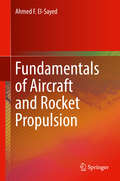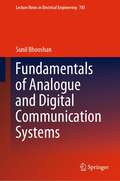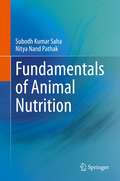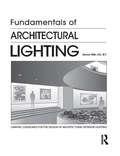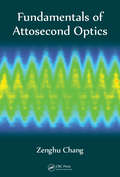- Table View
- List View
Fundamentals of Adsorption: Proceedings of the Fifth International Conference on Fundamentals of Adsorption (The Springer International Series in Engineering and Computer Science #356)
by M. Douglas LeVanFundamentals of Adsorption is the proceedings of the fifth International Conference on the Fundamentals of Adsorption, which was held on May 13-18, 1995 at the Asilomar Conference Center, Pacific Grove, California. This conference was organized completely under the auspices of the International Adsorption Society. It was attended by 196 participants from 24 countries. Members of the Scientific Advisory Board, together with the Conference Committee, selected papers for presentation from a large number of proposals involving an especially high level of international participation. The fundamental aspects of adsorption is a subject which has grown rapidly in recent years, drawing researchers from many disciplines including materials science, chemistry, physics, biochemistry and biotechnology, and chemical, civil, mechanical and environmental engineering. Fundamentals of Adsorption serves as an excellent reference and may be used as a primary text for a graduate level course on adsorption research or as a secondary text for a course on any of the disciplines mentioned above.
Fundamentals of Aeroelasticity
by Massimo GennarettiThis textbook provides the fundamentals of aeroelasticity, with particular attention to problems of interest to aeronautical engineering. The mathematical methods and tools applicable to the modern modeling of general aeroelastic problems are presented, discussed, and applied to fixed-wing aircraft configurations. It is composed of ten chapters divided into two parts: (I) aeroelastic modeling and analysis and (ii) mathematical tools. The six chapters that compose the first part start from the historical background of the discipline, then present the methods for coupling structural dynamics and unsteady aerodynamics for the aeroelastic modeling of the typical wing section, and then extend them to applications for twisted, tapered, swept finite-wing configurations. In this context, particular attention is paid to the presentation, interpretation, and discussion of the available unsteady sectional aerodynamic theories, both in the time and frequency domain, providing a broad scenario of the formulations that can be used for conventional and non-conventional aerodynamic/aeroelastic applications. For a modern view of aeroelasticity, a significant portion of the textbook deals with illustration and discussion of three-dimensional aerodynamic theories and computational methods for the determination of unsteady aerodynamic loads over lifting bodies in incompressible and compressible flows, as well as to the introduction and explanation of methodologies for the identification of reduced-order, state-space aerodynamic/aeroelastic operators suitable for stability (flutter) analysis and control purposes. A chapter is dedicated to the theories and approaches for aeroservoelastic modeling. In the second part of the textbook, additional chapters provide theoretical insights on topics that enrich the multidisciplinary knowledge related to widely applied methods and models for the analysis and solution of aeroelastic problems. The book serves as a reference tool for master's degree students in aeronautical/aerospace engineering, as well as researchers in the field of aeroelasticity.
Fundamentals of Agricultural and Field Robotics (Agriculture Automation and Control)
by Manoj Karkee Qin ZhangOver the past century, mechanization has been an important means for optimizing resource utilization, improving worker health and safety and reducing labor requirements in farming while increasing productivity and quality of 4F (Food, Fuel, Fiber, Feed). Recognizing this contribution, agricultural mechanization was considered as one of the top ten engineering achievements of 20th century by the National Academy of Engineering. Accordingly farming communities have adopted increasing level of automation and robotics to further improve the precision management of crops (including input resources), increase productivity and reduce farm labor beyond what has been possible with conventional mechanization technologies. It is more important than ever to continue to develop and adopt novel automation and robotic solutions into farming so that some of the most complex agricultural tasks, which require huge amount of seasonal labor such as fruit and vegetable harvesting, could be automated while meeting the rapidly increasing need for 4F. In addition, continual innovation in and adoption of agricultural automation and robotic technologies is essential to minimize the use of depleting resources including water, minerals and other chemicals so that sufficient amount of safe and healthy food can be produced for current generation while not compromising the potential for the future generation. This book aims at presenting the fundamental principles of various aspects of automation and robotics as they relate to production agriculture (the branch of agriculture dealing with farming operations from field preparation to seeding, to harvesting and field logistics). The building blocks of agricultural automation and robotics that are discussed in the book include sensing and machine vision, control, guidance, manipulation and end-effector technologies. The fundamentals and operating principles of these technologies are explained with examples from cutting-edge research and development currently going on around the word. This book brings together scientists, engineers, students and professionals working in these and related technologies to present their latest examples of agricultural automation and robotics research, innovation and development while explaining the fundamentals of the technology. The book, therefore, benefits those who wish to develop novel agricultural engineering solutions and/or to adopt them in the future.
Fundamentals of Air Cleaning Technology and Its Application in Cleanrooms
by Zhonglin XuFundamentals of Air Cleaning Technology and Its Application in Cleanrooms sets up the theoretical framework for cleanrooms. New ideas and methods are presented, which include the characteristic index of cleanrooms, uniform and non-uniform distribution characteristics, the minimum sampling volume, a new concept of outdoor air conditioning and the fundamentals of leakage-preventing layers. Written by an author who can look back on major scientific achievements and 50 years of experience in this field, this book offers a concise and accessible introduction to the fundamentals of air cleaning technology and its application. The work is intended for researchers, college teachers, graduates, designers, technicians and corporate R&D personnel in the field of HVAC and air cleaning technology.Zhonglin Xu is a senior research fellow at China Academy of Building Research.
Fundamentals of Aircraft and Rocket Propulsion
by Ahmed F. El-SayedThis book provides a comprehensive basics-to-advanced course in an aero-thermal science vital to the design of engines for either type of craft. The text classifies engines powering aircraft and single/multi-stage rockets, and derives performance parameters for both from basic aerodynamics and thermodynamics laws. Each type of engine is analyzed for optimum performance goals, and mission-appropriate engines selection is explained.Fundamentals of Aircraft and Rocket Propulsion provides information about and analyses of:thermodynamic cycles of shaft engines (piston, turboprop, turboshaft and propfan);jet engines (pulsejet, pulse detonation engine, ramjet, scramjet, turbojet and turbofan);chemical and non-chemical rocket engines;conceptual design of modular rocket engines (combustor, nozzle and turbopumps); andconceptual design of different modules of aero-engines in their design and off-design state.Aimed at graduate and final-year undergraduate students, this textbook provides a thorough grounding in the history and classification of both aircraft and rocket engines, important design features of all the engines detailed, and particular consideration of special aircraft such as unmanned aerial and short/vertical takeoff and landing aircraft. End-of-chapter exercises make this a valuable student resource, and the provision of a downloadable solutions manual will be of further benefit for course instructors.
Fundamentals of Airline Marketing (Aviation Fundamentals)
by Scott Ambrose Blaise WaguespackApplying fundamentals of marketing to commercial passenger air transportation, this textbook puts the emphasis on marketing principles and illustrative ways in which airlines can distinguish themselves within the highly competitive global marketplace. Fundamentals of Airline Marketing begins with a survey of current airline business strategies and the macro forces that have shaped the airline industry in the past and will continue to do so in the future. The growing importance of technology is discussed both from the perspective of better understanding customer needs and engaging more effectively with them. The central role of the "customer" is explored through the lens of modern segmentation and branding approaches. Coverage then shifts to the tactical decision areas consisting of the 4Ps—product, place, promotion, and price—in which marketers shape and execute their strategies. The book concludes with a focus on executing marketing initiatives internally through customer-facing employee groups and externally through the measurement and management of the customer experience. Fundamentals of Airline Marketing: • is an accessible textbook on the fundamentals of marketing for commercial passenger air transportation; • chronicles the marketing innovations and controversies that have been central to the historic shift in airline fortunes; • demonstrates how airline decisions fit within the fundamentals of marketing and how the marketplace is continuing to evolve; • provides a bridge between key marketing principles and their specific application to the airline industry in each chapter. This textbook is written primarily for undergraduate college students enrolled in aviation business administration programs and related courses. It will also serve as an accessible primer on airline marketing for industry professionals not presently working in marketing and for frontline airline employees seeking to learn more about marketing.
Fundamentals of Airline Marketing (Aviation Fundamentals)
by Scott Ambrose Blaise WaguespackApplying fundamentals of marketing to commercial passenger air transportation, this textbook puts the emphasis on marketing principles and illustrative ways in which airlines can distinguish themselves within the highly competitive global marketplace. Fundamentals of Airline Marketing begins with a survey of current airline business strategies and the macro forces that have shaped the airline industry in the past and will continue to do so in the future. The growing importance of technology is discussed both from the perspective of better understanding customer needs and engaging more effectively with them. The central role of the "customer" is explored through the lens of modern segmentation and branding approaches. Coverage then shifts to the tactical decision areas consisting of the 4Ps—product, place, promotion, and price—in which marketers shape and execute their strategies. The book concludes with a focus on executing marketing initiatives internally through customer-facing employee groups and externally through the measurement and management of the customer experience. Fundamentals of Airline Marketing: • is an accessible textbook on the fundamentals of marketing for commercial passenger air transportation; • chronicles the marketing innovations and controversies that have been central to the historic shift in airline fortunes; • demonstrates how airline decisions fit within the fundamentals of marketing and how the marketplace is continuing to evolve; • provides a bridge between key marketing principles and their specific application to the airline industry in each chapter. This textbook is written primarily for undergraduate college students enrolled in aviation business administration programs and related courses. It will also serve as an accessible primer on airline marketing for industry professionals not presently working in marketing and for frontline airline employees seeking to learn more about marketing.
Fundamentals of Airplane Flight Mechanics
by David G. HullFlight mechanics is the application of Newton's laws to the study of vehicle trajectories (performance), stability, and aerodynamic control. This volume details the derivation of analytical solutions of airplane flight mechanics problems associated with flight in a vertical plane. It covers trajectory analysis, stability, and control. In addition, the volume presents algorithms for calculating lift, drag, pitching moment, and stability derivatives. Throughout, a subsonic business jet is used as an example for the calculations presented in the book.
Fundamentals of Amorphous Solids: Structure and Properties
by Zbigniew H. StachurskiLong awaited, this textbook fills the gap for convincing concepts to describe amorphous solids. Adopting a unique approach, the author develops a framework that lays the foundations for a theory of amorphousness. He unravels the scientific mysteries surrounding the topic, replacing rather vague notions of amorphous materials as disordered crystalline solids with the well-founded concept of ideal amorphous solids. A classification of amorphous materials into inorganic glasses, organic glasses, glassy metallic alloys, and thin films sets the scene for the development of the model of ideal amorphous solids, based on topology- and statistics-governed rules of three-dimensional sphere packing, which leads to structures with no short, mid or long-range order. This general model is then concretized to the description of specific compounds in the four fundamental classes of amorphous solids, as well as amorphous polyethylene and poly(methyl)methacrylate, emphasizing its versatility and descriptive power. Finally, he includes example applications to indicate the abundance of amorphous materials in modern-day technology, thus illustrating the importance of a better understanding of their structure and properties. Equally ideal as supplementary reading in courses on crystallography, mineralogy, solid state physics, and materials science where amorphous materials have played only a minor role until now.
Fundamentals of Amorphous Solids: Structure and Properties
by Zbigniew H. StachurskiLong awaited, this textbook fills the gap for convincing concepts to describe amorphous solids. Adopting a unique approach, the author develops a framework that lays the foundations for a theory of amorphousness. He unravels the scientific mysteries surrounding the topic, replacing rather vague notions of amorphous materials as disordered crystalline solids with the well-founded concept of ideal amorphous solids. A classification of amorphous materials into inorganic glasses, organic glasses, glassy metallic alloys, and thin films sets the scene for the development of the model of ideal amorphous solids, based on topology- and statistics-governed rules of three-dimensional sphere packing, which leads to structures with no short, mid or long-range order. This general model is then concretized to the description of specific compounds in the four fundamental classes of amorphous solids, as well as amorphous polyethylene and poly(methyl)methacrylate, emphasizing its versatility and descriptive power. Finally, he includes example applications to indicate the abundance of amorphous materials in modern-day technology, thus illustrating the importance of a better understanding of their structure and properties. Equally ideal as supplementary reading in courses on crystallography, mineralogy, solid state physics, and materials science where amorphous materials have played only a minor role until now.
Fundamentals of Analogue and Digital Communication Systems (Lecture Notes in Electrical Engineering #785)
by Sunil BhooshanThe book covers fundamentals and basics of engineering communication theory. It presents right mix of explanation of mathematics (theory) and explanation. The book discusses both analogue communication and digital communication in details. It covers the subject of ‘classical’ engineering communication starting from the very basics of the subject to the beginning of more advanced areas. It also covers all the basic mathematics which is required to read the text. It covers a two semester course as an undergraduate text and some topics in master’s course as well.
The Fundamentals of Analysis for Talented Freshmen (Synthesis Lectures on Mathematics & Statistics)
by Peter M. Luthy Guido L. Weiss Steven S. XiaoThis book assumes the students know some of the basic facts about Calculus. We are very rigorous and expose them to the proofs and the ideas which produce them. In three chapters, this book covers these number systems and the material usually found in a junior-senior advanced Calculus course. It is designed to be a one-semester course for "talented" freshmen. Moreover, it presents a way of thinking about mathematics that will make it much easier to learn more of this subject and be a good preparation for more of the undergraduate curriculum.
Fundamentals of Animal Nutrition
by Subodh Kumar Saha Nitya Nand PathakThe book provides comprehensive information about the different aspects of veterinary nutrition in tropical countries.The introductory chapter discuss the importance of nutrition, feeds and feeding of balanced and optimum feeds specifically required for the sustenance of life. The second chapter, discusses briefly the history of research in animal nutrition.The book further talks about the relationship between the environment and nutrition in animals; the chemical composition of plants and animals; and the various sources of feed for animals. It provides details on the different phases of life cycle in animals, and the effect of nutrition on the performance. Various Nutrients and its importance in livestock nutritionand production has been illustrated in details. Various nutrients such as water, carbohydrate, protein, fats, vitamins, minerals etc are individually dealt in a separate chapter. The digestive system,digestion and metabolism of carbohydrates, protein and fats in ruminant and non ruminant livestock have been illustrated. A dedicated chapter fully describes the activity of enzymes which are directly involved in nutrition. Also this book deals with the harmful components of animal feed which are found mainly in the unconventional feeds. The books also provide chapters like partitioning of feed& energy and also the therapeutic and clinical nutrition which are very importantfor the under graduate & post graduate students and researchers of animal nutrition and livestock production and management. This book is useful for researchers, undergraduate and post graduate students studying veterinary sciences, animal husbandry, zoology and biochemistry.
Fundamentals of Aperture Antennas and Arrays: From Theory to Design, Fabrication and Testing
by Trevor S. BirdThis book is intended as an advanced text for courses in antennas, with a focus on the mature but vital background field of aperture antennas. The book is aimed at final year, MSc, PhD and Post-Doctoral students, as well as readers who are moving from academia into industry, beginning careers as wireless engineers, system designers, in R&D, or for practising engineers. It assumes the reader has undertaken an earlier course of study on Maxwell's equations, fields and waves. Some of these topics are summarised in the early few chapters in order to provide continuity and background for the remaining chapters. The aperture antennas covered include the main types of horns, reflectors and arrays as well as microstrip patches, reflectarrays and lenses. To provide more than a superficial treatment of arrays, the topic of mutual coupling is covered in greater detail than most similar books in the area. Also included is an introduction to arrays on non-planar surfaces, which is of importance for applications that involve curved surfaces such as in aerodynamics or for making aperture antennas unobtrusive. A chapter is included on some modern aperture antennas to illustrate design techniques beyond the most common types of aperture antennas described in the early chapters. This is to show where advances have recently been made and where they could be improved in the future. Also included are selected topics of a practical nature for aperture antennas, namely fabrication and measurement.
Fundamentals of Aperture Antennas and Arrays: From Theory to Design, Fabrication and Testing
by Trevor S. BirdThis book is intended as an advanced text for courses in antennas, with a focus on the mature but vital background field of aperture antennas. The book is aimed at final year, MSc, PhD and Post-Doctoral students, as well as readers who are moving from academia into industry, beginning careers as wireless engineers, system designers, in R&D, or for practising engineers. It assumes the reader has undertaken an earlier course of study on Maxwell's equations, fields and waves. Some of these topics are summarised in the early few chapters in order to provide continuity and background for the remaining chapters. The aperture antennas covered include the main types of horns, reflectors and arrays as well as microstrip patches, reflectarrays and lenses. To provide more than a superficial treatment of arrays, the topic of mutual coupling is covered in greater detail than most similar books in the area. Also included is an introduction to arrays on non-planar surfaces, which is of importance for applications that involve curved surfaces such as in aerodynamics or for making aperture antennas unobtrusive. A chapter is included on some modern aperture antennas to illustrate design techniques beyond the most common types of aperture antennas described in the early chapters. This is to show where advances have recently been made and where they could be improved in the future. Also included are selected topics of a practical nature for aperture antennas, namely fabrication and measurement.
Fundamentals of Applied Animal Nutrition
by Gordon DrydenIf you have ever wondered why animals prefer some foods and not others, how poor feeding management can cause conditions such as laminitis, rumenitis or diarrhoea, or how to construct a diet to optimise animal performance and health, then this book will introduce you to the fundamentals of animal nutrition and their practical implementation. While giving a comprehensive and practical overview of the principles that underpin the design and management of farm animal feeding systems, this book: - Covers a wide range of topics from digestive function, nutrients and feed composition, to intake, feed related disorders, grazing behaviour and management, as well as how animals influence climate change and the environment. - Contains hints, tips and practical advice on animal feeding. - Includes links to the latest data on feed composition and nutrient requirements. - Is a companion book to the author's book titled Animal Nutrition Science. With its evidence-based approach and emphasis on the practical throughout, this is a valuable textbook for undergraduate and graduate animal science students studying the feeding of farm animals. It is also an essential reference for early practitioners, veterinarians, farm managers and advisers in animal feed companies.
Fundamentals Of Aquatic Toxicology: Effects, Environmental Fate And Risk Assessment
by Gary M. RandThis text is divided into three parts. The first part describes basic toxicological concepts and methodologies used in aquatic toxicity testing, including the philosophies underlying testing strategies now required to meet and support regulatory standards.The second part of the book discusses various factors that affect transport, transformation, ultimate distribution, and accumulation of chemicals in the aquatic environment, along with the use of modelling to predict fate.; The final section of the book reviews types of effects or endpoints evaluated in field studies and the use of structure-activity relationships in aquatic toxicology to predict biological activity and physio-chemical properties of a chemical. This section also contains an extensive background of environmental legislation in the USA and within the European Community, and an introduction to hazard/risk assessment with case studies.
Fundamentals Of Aquatic Toxicology: Effects, Environmental Fate And Risk Assessment
by Gary M. RandThis text is divided into three parts. The first part describes basic toxicological concepts and methodologies used in aquatic toxicity testing, including the philosophies underlying testing strategies now required to meet and support regulatory standards.The second part of the book discusses various factors that affect transport, transformation, ultimate distribution, and accumulation of chemicals in the aquatic environment, along with the use of modelling to predict fate.; The final section of the book reviews types of effects or endpoints evaluated in field studies and the use of structure-activity relationships in aquatic toxicology to predict biological activity and physio-chemical properties of a chemical. This section also contains an extensive background of environmental legislation in the USA and within the European Community, and an introduction to hazard/risk assessment with case studies.
Fundamentals of Arc Spraying: Physical and Chemical Regularities
by Vladislav Boronenkov Yury KorobovThis book guides readers through the systematic analysis of Arc Spraying: one of the most widespread and important thermal spraying methods. Along the way, readers from industry and research laboratories become familiar with the features of the process and physical-chemical regulations of particles in flight, coating formation, internal coating properties, and their output parameters. The book is ideal for engineers, technicians, and scientists engaged in welding and thermal spraying and stands as an excellent reference for students interested in advanced coatings technology.
Fundamentals of Architectural Lighting
by Samuel MillsThe theme of this book is that light is an inseparable part of architectural design, and is intended to provide students of architecture and interior design with a graphic guideline to the fundamental role lighting plays in this process. While simple light sources may be enough to satisfy practical needs, the design process must expand beyond basic illumination. The challenge for architects and designers is the creation of luminous environments offering visual interest and a sense of well-being, while also meeting basic seeing needs. Technological advances provide opportunities for the lighting designer's creative introduction of light, and the visual and psychological perceptions of the illuminated architectural environment. Fundamentals of Architectural Lighting offers a complete comprehensive guide to the basics of lighting design, equipping students and practitioners with the tools and ideas they need to master a variety of lighting techniques. The book is extensively illustrated with over 250 illustrations to demonstrate basic principles and procedures. It is an excellent resource for anyone interested in the fundamentals of integrated lighting for architectural interior spaces.
Fundamentals of Architectural Lighting
by Samuel MillsThe theme of this book is that light is an inseparable part of architectural design, and is intended to provide students of architecture and interior design with a graphic guideline to the fundamental role lighting plays in this process. While simple light sources may be enough to satisfy practical needs, the design process must expand beyond basic illumination. The challenge for architects and designers is the creation of luminous environments offering visual interest and a sense of well-being, while also meeting basic seeing needs. Technological advances provide opportunities for the lighting designer's creative introduction of light, and the visual and psychological perceptions of the illuminated architectural environment. Fundamentals of Architectural Lighting offers a complete comprehensive guide to the basics of lighting design, equipping students and practitioners with the tools and ideas they need to master a variety of lighting techniques. The book is extensively illustrated with over 250 illustrations to demonstrate basic principles and procedures. It is an excellent resource for anyone interested in the fundamentals of integrated lighting for architectural interior spaces.
Fundamentals of Artificial Intelligence
by K.R. ChowdharyFundamentals of Artificial Intelligence introduces the foundations of present day AI and provides coverage to recent developments in AI such as Constraint Satisfaction Problems, Adversarial Search and Game Theory, Statistical Learning Theory, Automated Planning, Intelligent Agents, Information Retrieval, Natural Language & Speech Processing, and Machine Vision. The book features a wealth of examples and illustrations, and practical approaches along with the theoretical concepts. It covers all major areas of AI in the domain of recent developments. The book is intended primarily for students who major in computer science at undergraduate and graduate level but will also be of interest as a foundation to researchers in the area of AI.
Fundamentals of Attosecond Optics
by Zenghu ChangAttosecond optical pulse generation, along with the related process of high-order harmonic generation, is redefining ultrafast physics and chemistry. A practical understanding of attosecond optics requires significant background information and foundational theory to make full use of these cutting-edge lasers and advance the technology toward the n
Fundamentals of Automatic Process Control (Chemical Industries Ser.)
by Uttam Ray ChaudhuriStrong theoretical and practical knowledge of process control is essential for plant practicing engineers and operators. In addition being able to use control hardware and software appropriately, engineers must be able to select or write computer programs that interface the hardware and software required to run a plant effectively. Designed to help
Fundamentals of Automotive and Engine Technology: Standard Drives, Hybrid Drives, Brakes, Safety Systems (Bosch Professional Automotive Information)
by Konrad ReifHybrid drives and the operation of hybrid vehicles are characteristic of contemporary automotive technology. Together with the electronic driver assistant systems, hybrid technology is of the greatest importance and both cannot be ignored by today’s car drivers. This technical reference book provides the reader with a firsthand comprehensive description of significant components of automotive technology. All texts are complemented by numerous detailed illustrations.




